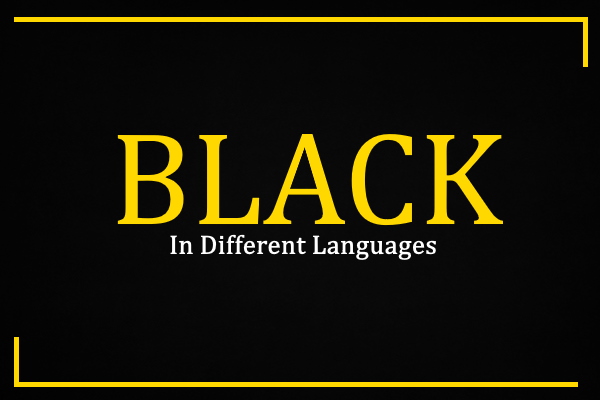| Different Languages | Translation of Black |
|---|---|
| Basque | beltza |
| Albanian | e zezë |
| Albanian | e zezë |
| Basque | beltza |
| Belarusian | чорны |
| Bosnian | crn |
| Bulgarian | черно |
| Catalan | negre |
| Croatian | crno |
| Czech | Černá |
| Danish | sort |
| Dutch | zwart |
| Estonian | must |
| Finnish | musta |
| French | noir |
| Galician | negro |
| German | schwarz |
| Greek | μαύρος (mávros) |
| Hungarian | fekete |
| Icelandic | Svartur |
| Irish | dubh |
| Italian | nero |
| Latvian | melns |
| Lithuanian | juodas |
| Macedonian | црна |
| Maltese | iswed |
| Norwegian | svart |
| Polish | czarny |
| Portuguese | Preto |
| Romanian | negru |
| Russian | черный (chernyy) |
| Serbian | црн (crn) |
| Slovak | čierna |
| Slovenian | črna |
| Spanish | negro |
| Swedish | svart |
| Ukrainian | чорний (chornyy) |
| Welsh | du |
| Yiddish | שוואַרץ |
| Armenian | Սեվ |
| Azerbaijani | qara |
| Bengali | কালো |
| Chinese Simplified | 黑色 (hēisè) |
| Chinese Traditional | 黑色 (hēisè) |
| Georgian | შავი |
| Gujarati | કાળા |
| Hindi | काली |
| Hmong | dub |
| Japanese | 黒 |
| Kannada | ಕಪ್ಪು |
| Kazakh | қара |
| Khmer | ខ្មៅ |
| Korean | 검은 (geom-eun) |
| Lao | ສີດໍາ |
| Malayalam | കറുത്ത |
| Marathi | काळा |
| Mongolian | хар |
| Myanmar (Burmese) | အနက်ရောင် |
| Nepali | कालो |
| Sinhala | කලු |
| Tajik | сиёҳ |
| Tamil | கருப்பு |
| Telugu | బ్లాక్ |
| Thai | สีดำ |
| Turkish | siyah |
| Urdu | سیاہ |
| Uzbek | qora |
| Vietnamese | đen |
| Arabic | أسود ('aswad) |
| Hebrew | שָׁחוֹר |
| Persian | سیاه |
| Afrikaans | swart |
| Chichewa | wakuda |
| Hausa | baki |
| Igbo | black |
| Sesotho | ba batsho |
| Somali | madow |
| Swahili | nyeusi |
| Yoruba | dudu |
| Zulu | black |
| Cebuano | itom |
| Filipino | itim |
| Indonesian | hitam |
| Javanese | ireng |
| Malagasy | mainty |
| Malay | hitam |
| Maori | pango |
| Esperanto | nigra |
| Haitian Creole | nwa |
| Latin | nigrum |

Arslan Hussain, founder of The Different Languages, is an experienced translator passionate about languages and cultures. Through his website, he shares his knowledge and love for different languages, making learning accessible and enjoyable.

